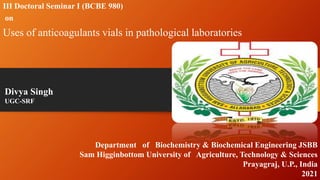3 rd presentation
•Download as PPTX, PDF•
0 likes•24 views
This document discusses the uses of anticoagulant vials in pathological laboratories. It describes the three sources of blood that can be collected: capillary, venous, and arterial. It then explains the different types of anticoagulants used including EDTA, citrate, heparin, fluoride/oxalate and their purposes. EDTA is used for complete blood counts and coagulation profiles. Citrate and heparin are used to prevent clotting for coagulation studies. Fluoride/oxalate is used specifically for blood glucose testing. The document provides details on collection methods, tube colors and the mechanisms by which different anticoagulants prevent clotting.
Report
Share
Report
Share

Recommended
More Related Content
What's hot
What's hot (20)
Automated blood cell counter by prof. dr. ma mohsin

Automated blood cell counter by prof. dr. ma mohsin
Skill lab (hematology, physiology, microbiology, biochemistry)

Skill lab (hematology, physiology, microbiology, biochemistry)
Blood component, sample collection, storage, preservation

Blood component, sample collection, storage, preservation
Similar to 3 rd presentation
Similar to 3 rd presentation (20)
Sample collection, Preservation and its Estimation

Sample collection, Preservation and its Estimation
Practical 1 Methods of Obtaining Blood Samples Choice of Anticoagulants and P...

Practical 1 Methods of Obtaining Blood Samples Choice of Anticoagulants and P...
Human Sample Collection - An Introduction to Clinical Chemistry

Human Sample Collection - An Introduction to Clinical Chemistry
More from SHUATS
More from SHUATS (7)
Recently uploaded
Mehran University Newsletter is a Quarterly Publication from Public Relations OfficeMehran University Newsletter Vol-X, Issue-I, 2024

Mehran University Newsletter Vol-X, Issue-I, 2024Mehran University of Engineering & Technology, Jamshoro
Recently uploaded (20)
Jual Obat Aborsi Hongkong ( Asli No.1 ) 085657271886 Obat Penggugur Kandungan...

Jual Obat Aborsi Hongkong ( Asli No.1 ) 085657271886 Obat Penggugur Kandungan...
General Principles of Intellectual Property: Concepts of Intellectual Proper...

General Principles of Intellectual Property: Concepts of Intellectual Proper...
Micro-Scholarship, What it is, How can it help me.pdf

Micro-Scholarship, What it is, How can it help me.pdf
HMCS Max Bernays Pre-Deployment Brief (May 2024).pptx

HMCS Max Bernays Pre-Deployment Brief (May 2024).pptx
Sensory_Experience_and_Emotional_Resonance_in_Gabriel_Okaras_The_Piano_and_Th...

Sensory_Experience_and_Emotional_Resonance_in_Gabriel_Okaras_The_Piano_and_Th...
On National Teacher Day, meet the 2024-25 Kenan Fellows

On National Teacher Day, meet the 2024-25 Kenan Fellows
UGC NET Paper 1 Mathematical Reasoning & Aptitude.pdf

UGC NET Paper 1 Mathematical Reasoning & Aptitude.pdf
Basic Civil Engineering first year Notes- Chapter 4 Building.pptx

Basic Civil Engineering first year Notes- Chapter 4 Building.pptx
HMCS Vancouver Pre-Deployment Brief - May 2024 (Web Version).pptx

HMCS Vancouver Pre-Deployment Brief - May 2024 (Web Version).pptx
Unit-V; Pricing (Pharma Marketing Management).pptx

Unit-V; Pricing (Pharma Marketing Management).pptx
3 rd presentation
- 1. III Doctoral Seminar I (BCBE 980) on Uses of anticoagulants vials in pathological laboratories Divya Singh UGC-SRF Department of Biochemistry & Biochemical Engineering JSBB Sam Higginbottom University of Agriculture, Technology & Sciences Prayagraj, U.P., India 2021
- 2. Contents Sources Methods of blood collection Venous blood vs arterial blood vs capillary blood Types of anticoagulants used (color coding)
- 3. Blood can be collected from 3 different sources: 1. Capillary blood. 2. Venous blood. 3. Arterial blood. CAPILLARY BLOOD – METHOD OF COLLECTION : Select the least used finger. Cleanse the site with alcohol swab. Puncture across the grain of the skin And transfer blood to a strip or small container.
- 5. Indications: To draw a small amount of blood In a microtube or strip for blood sugar and bleeding time tests. For infants and young children.
- 7. Radial artery and brachial artery femoral artery
- 8. Blood collection for venous blood: Equipment required: •Tourniquet. •Vacutainer and syringe. •Alcohol swab. •Bandage Most common Majority of routine tests are performed on venous blood. Blood can be taken directly from the vein. The best site - deep veins of the ante-cubital fossa.
- 9. Fore arm vein: other sites are: Dorsum of hand Femoral vein
- 11. SERUM: Liquid remaining after blood has clotted naturally in a plain tube. It’s the most common specimen required for chemical and serological test. PLASMA: A fluid obtained from anticoagulated and centrifuged blood Plasma is required for Coagulation Profile and Fibrinogen Assay.
- 12. ANTICOAGULANT TUBE/ VACUTAINER EDTA (Ethylene Diamine Tetra-Acetate) liquid: Types: Na and K2 EDTA (2.0mg /ml, Mechanism: forming Ca salts to remove Ca. Uses: CBC, PCR, PS and HbA1c. Requires full draw (invert 8 times). EDTAAvailable as: Disodium EDTA Dipotassium EDTA Uses: 1. cell counts 2. smears & 3. platelet counts
- 13. RED (PLAINTUBE): No preservative/anticoagulant. Uses: usually for toxicology and serology
- 14. SST (SERUM SEPARATOR TUBE) No additives. Clotting accelerator and separation gel. Uses: Chemistry, Immunology, and Serology.
- 15. Sodium citrate : (1:9 ratio). Anticoagulant: 3.2% Mechanism: Calcium chelation. Use: Coagulation studies and platelet function. BLACK: Na citrate 1:4. 3.8% of sodium citrate Action: Remove calcium. Uses: Westergren – Erythrocyte Sedimentation Rate (ESR).
- 16. • Citrate •Action: - Binds Ca in a non-ionsed but soluble complex. •Disadvantage: - It is a liquid - not acceptable for blood cell counts & Hb estimation. HEPARIN: Sodium Heparin or Lithium Heparin (Green) 0.5 to 1.0mg per 5ml of blood Mechanism: inactivation of thrombin and thromboplastin. Uses: - For Lithium level - Na Heparin anticoagulant. - For Ammonia level - Na or Lithium Heparin Heparin • Uses: -naturally occuring biological anti-coagulant -Used in hematological special tests, biochemistry for electrolytes For blood gases -Transfusions
- 17. GREY: Sodium fluoride + Potassium oxalate MOA: inhibits red cell glycolytic pathway Used: blood glucose Oxalate Potasium oxalate: - concentration is 2mg/ml blood - shrinkage of RBC’s, so 8% shrinkage in PCV - used for chemical analysis -Not used for PCV, ESR, cell morphology Ammonium oxalate: - concentration 2mg/ml blood - Adr: swelling of RBC - Not used for PCV, ESR
- 18. References • WHO-World Health Organization(2018)-Use of anticoagulants in diagnostic laboratory investigations, WHO/DIL/LAB/00.1 Rev.2.
